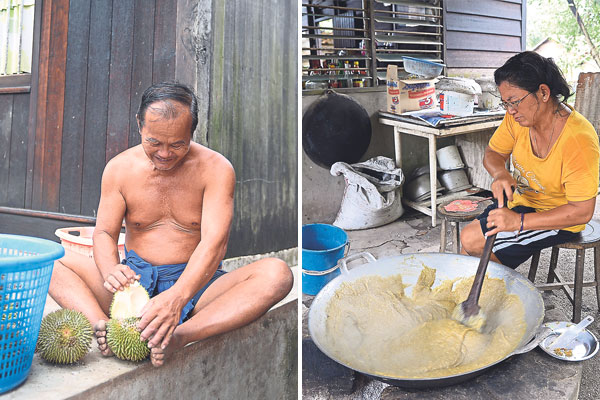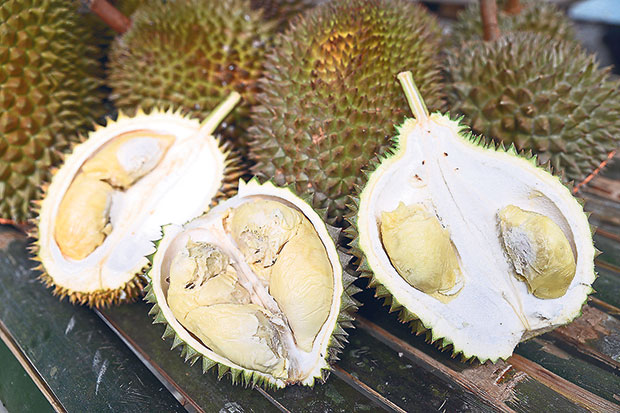GEORGE TOWN, June 28 — Every year, between May and August, durian lovers flock to roadside durian stalls and the numerous farms all around Balik Pulau for a taste of the King of Fruits.
The durian is one fruit that draws visitors from near and far every year and it is no wonder as its creamy, sweet and rich flesh is unlike that of any other fruit.
Hundreds of makeshift durian stalls will pop up all over the island during this period to offer all types of durians from the popular Musang King to the common durian kampung.
It can be rather overwhelming as you are bound to find a durian stall, or even just a vendor on a motorbike offering durians from a basket, on every street corner and along busy main roads — especially Jalan Tun Sardon in Balik Pulau town.
For real durian aficionados, not every roadside stall will suffice as their durians may not be up to standard or are not fresh enough.
Like wine, there are many different “brands” of durians and each brand boasts a unique fragrance, flavour and texture.
But unlike wine, durians are best eaten fresh, preferably within the first few hours of it falling from the tree, for one to be able to enjoy the full robust flavours of the fruit.
We took a trip along the winding roads of Balik Pulau and visited some farms, each offering a unique durian eating experience. Here’s our pick of the crop:


Lim Brothers Farm
Mk 5, Titi Serong, Balik Pulau
Tel: 04-8668551
This farm, also known as Peng Siew Farm, offers a wide variety of hybrid durians such as Musang King, Or Chi (black stone), Hor Lor (Labu), Kun Poh, 101, D14, Capri and many more. They have more than 20 different types of durians from their durian orchards, one right behind their farm house and another a distance away.
The farm itself, located just along the Titi Serong road with only a few parking lots within its grounds, is not just for durians as they also have a poultry farm so they are wholesalers of fresh farm eggs too.
Though there is much demand for Musang King, they have other hybrids which the farmers say taste better than the over-rated Musang King.
“Musang King is quite a common hybrid all durian farms have, it was only popularised due to some celebrity but if you really know your durians, you would go for the really good ones such as Hor Lor and Kun Poh,” one of the Lim brothers, Chong Teng, said as he picked a batch of durians for his clients.
The farm is open daily between 10am and 8pm from late May until July.

Okay Jungle Durians
Mk 4, Titi Serong, Balik Pulau
Tel: 012-5711557
Many vegetable farms are now very conscious of the demand for organic products and this durian and fruit farm, located right next to the Titi Serong river, is pesticide-free and strives to be organic.
The durian trees have been around since the 1950s so the farm offers strong flavourful durians from matured trees that, according to the owner, Choy, are all fertilized using only natural ingredients like chicken droppings.
“We specialise in jungle durians, what some would call durian kampung, that come from matured trees and are all natural, not hybrids,” Choy said.
The jungle durians do not have any specific names or brands but each tree produces a different flavour and texture of durians much like the hybrids.
Choy said there are many durian lovers who crave the taste of traditional wild durians, almost like a throwback to old times where there were very few hybrid durians.
The farm also offers hybrid durians such as Ang Heh (red prawns), Hor Lor, D11, Capri and D14. Customers will have to call ahead to book as the farm mostly sells its durian stock to wholesalers every morning.

Bao Sheng Durian Farm
Titi Kerawang, Balik Pulau
Tel: 012-411 0600
If you have ever wondered what a durian farm is really like, this farm’s owner, Chang Teik Seng, has taken the initiative to include a farm tour for his visitors.
Chang, whom everyone calls Durian Seng, will take groups of customers on a tour of his farm to explain about the many types of durians, the whole process of picking the durians, how to choose durians and the different flavours of each type of durian.
At the end of the tour, customers will get to join in a “durian tasting” session where Chang or his assistants will explain the tastes and flavours of each type of durian.
The farm specialises in Ang Heh, Hor Lor, Kun Poh, Green Skin, D604 and Little Red.
“We will explain to them why the tastes of the different durians differ, how some can taste bitter, sweet and with a strong wine flavour or how some can produce a numb sensation when eaten,” he said.
There are three packages for customers to choose from, package one for durians from young trees, package two for durians from matured trees and the last package is for freshly picked durians that give that “numb” sensation when eaten.
According to Chang, the flavours of the same durian vary according to the length of time it dropped from the tree.
If the fruit is eaten within the first two hours from dropping from the tree, it will produce the numbing sensation along with multi-level flavours while the numbing sensation will wear off once the fruit is more than two hours old.

Here is a guide on the flavours of six popular durians, according to Chang:
Ang Heh (red prawn)
As with its name, the flesh is reddish and soft and it is sweet with a slight bitter taste. It has small seeds and very thick and creamy flesh. This hybrid has been an old favourite since it was declared a champion breed back in 1989.
Hor Lor (Labu / Gourd)
The fruit itself is identified by its shape, like a gourd. The flesh is creamy, very sticky and sweet but it sometimes might have a bitter taste, depending on how hard it landed when it dropped from the tree. This was another durian champion back in 1988.
Kun Poh Ang Bak
This durian is named after the late Lau Khun Poh, who first bud-crafted it, while the ang bak refers to the reddish golden colour of the flesh. This durian has a very heavy and strong aroma and its flesh is creamy with a bittersweet taste. It was a durian champion in 1991.
Green Skin Ang Bak
This durian is easy to identify as it has a bright green skin unlike the other types. It is another bittersweet durian with a thick and creamy texture.
D604
This durian was first cultivated by the late Teh Hew Hong of Sungai Pinang in Balik Pulau and unlike the others that have reddish orange flesh, this one has a pale yellow flesh. It is sweet and the texture is sticky.
Little Red
Like its name suggests, the flesh of this durian is red and the durian is usually small. The flesh is creamy but not sticky and it is not as sweet but is a balance of slightly sweet and slightly bitter.






















